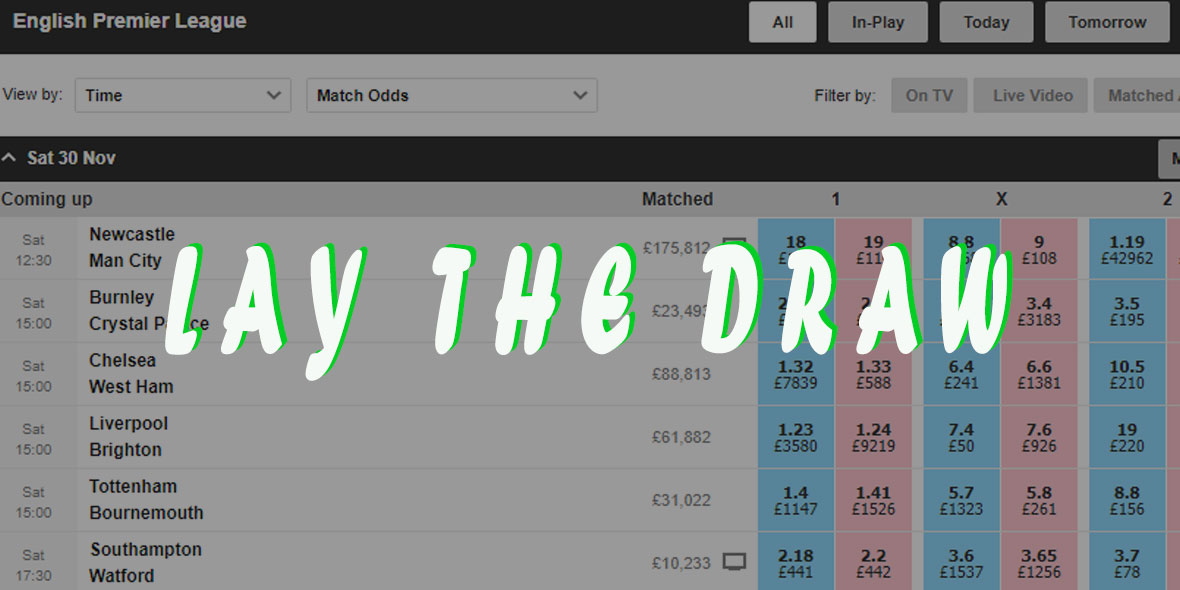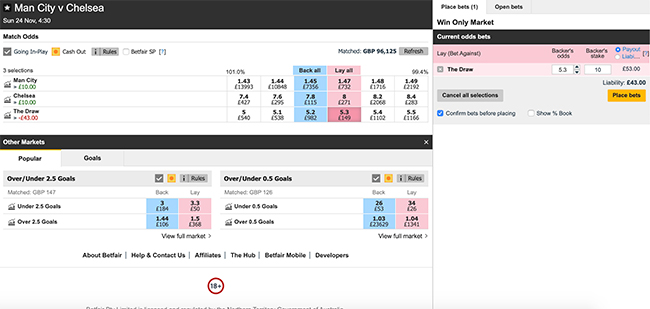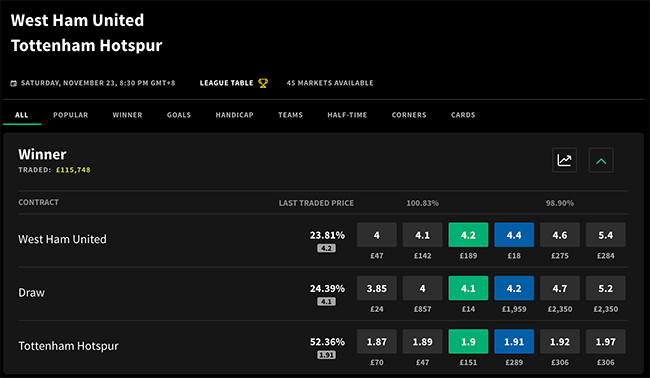Lay The Draw: How And When To Do It

Laying the draw is one of a handful of regular techniques that most Betfair traders have used at one point, and has been popular since the early 2000s.
In this guide, we will look at what it means to lay the draw, which games are most appropriate for this tactic, and how we can adapt our strategy to keep our risk as low as we can.

What Is Lay The Draw?
Laying the draw relies on the use of a betting exchange, rather than a traditional bookmaker. Understanding a ‘lay’ bet is essential for this strategy.
A lay bet is one in which you yourself play the role of the bookmaker.
You are offering to take someone’s bet at specific odds you have chosen. In this situation, your winnings will be the stake of whoever takes your bet, and your liability (how much you can lose) is the stake multiplied by the odds.
We recommend using Betfair as your trading platform, although there are a few other betting exchanges out there such as Smarkets which do have pretty good liquidity.


As you can see, for the upcoming West Ham v Tottenham match, more money has been traded on Smarkets than on Betfair. However, there are 3 days to go before the match, and this may change by matchday.
On Betfair, the lay odds are displayed in red, next to the back odds. The middle column contains the best odds currently available, with the staking amount available displayed underneath the odds.

Laying the draw means you are betting against the draw occurring. This means that you will win your bet if anything other than a draw is the final outcome (for football, either of the two teams winning).
We will be looking at laying the draw as a trading strategy. As a trader, we will always look to minimise our risk as much as possible and take a guaranteed profit whenever we get the opportunity.
Lay the draw trading is all about being able to trade out of your position for a profit when one team scores.
There are a few different situations where this works, and somewhere it does not. Therefore we have to make sure we choose the right games.
How To Choose The Right Games
As you become more experienced with laying the draw, you will see there are plenty of different situations in which you can take advantage of laying the draw.
We will start by going through some of the easiest and most common methods.
As always, we are looking for matches with good liquidity.
This means there is a lot of money moving through the market, and there is less likelihood of your bet not being taken. Using Betfair means that we can usually count on pretty good liquidity for football matches, especially in the Premier League.

The most common matches to look out for are those which should be high-scoring affairs. Laying the draw relies on one team scoring. Look for games where both teams usually favour an attacking, expansive style of play.
Many people will choose a game where one team is heavily favoured, such as the league-leaders against an underdog from the bottom of the league table, and assume the favoured team will win, and therefore score at some point.
However, sometimes these games can be low-scoring affairs where the underdog simply parks the bus for 90 minutes. This can lead to a stalemate where neither team scores, and you run the risk of losing your bet before you get a chance to trade out.
Closely matched teams who both tend to score a lot of goals are usually the games you want to look for.
As soon as one of the team’s scores, the odds for a draw will increase, and you should be able to exit out of your position by backing a draw for a better price.
How To Use Lay The Draw
Once we have found a match that fits all of our criteria, we can use our strategy. Never get greedy and try to use it with any match that pops up. A sensible trader knows only to take the opportunities that are in their best interest.
We will use the example of the upcoming Man City v Chelsea game to demonstrate. The odds for a draw are a little high, but still within acceptable boundaries.

We pick the lay option in the Draw row. The best odds we can get right now are 5.3, so we offer a £10 stake, meaning our total liability if we lose our bet will be £43.00.
If either of the team’s scores, the odds of a draw occurring should decrease. At this point, we can exit out of our position by backing the draw for a better price, and guarantee a profit.
An issue with this match is that Man City are very heavily favoured to win. If Chelsea score first, early on in the match, the odds for the draw may actually decrease, as punters expect Man City to score and level up the scoreline.
There are ways around this problem that we will cover in the next section.
How To Minimise Risk
There are a few situations we look to avoid when laying the draw.
As we said previously, we are usually waiting for one team to score so that the odds of a draw occurring decrease, and we can exit out of our position for a profit.
This falls through when one team is heavily favoured, and the underdog scores first, early on in the match. In this situation, the odds for a draw may actually increase, as the favoured team will be expected to score at some point and even things up.
This takes away our opportunity to trade out for a profit and is, therefore, something we will seek to avoid. We can deal with this problem in a few different ways.
Firstly, avoiding games where one team is heavily favoured is a simple way to combat this issue. Different traders have different preferences, but most usually look for matches where the odds for a draw are between 3.5 and 5.0.
If the odds for a draw are less than 3.5, it is usually worth avoiding the match. The potential for loss outweighs the potential gain, and it is better to find a more reliable game.

If you find yourself in a position where the underdog has scored first and thereby created a situation where you cannot exit out for a profit, there are still a couple of different options.
Every game is different, and you have to use your experience to decide the best course of action. As a trader, we have to accept our losses when they come, but attempt to minimise them as much as possible.
It is usually best practice to exit out of your position as soon as the underdog scores. You might lose around 50% of your stake, but this is better than 100%.
You should take every game as it comes. If the underdog has scored very early on against the run of play, you could maintain your position, and hope that the favourite scores twice over the rest of the match.
If the underdog is playing much better football and looks like scoring again, then you can also stay in your position and hope the match ends in a win for the underdog.
Another, more risky tactic, is to lay the underdog if they score first. In this situation, you are essentially doubling down on the favourite scoring next.
It is best to gain some experience in laying the draw before attempting this kind of strategy, as you are increasing your liability.
Another issue with laying the draw is that sometimes neither team scores for the majority of the match. You are relying on one team scoring to be able to exit out of your position for a profit.
Reducing Liability
If it is looking like the match will end in a goalless draw, it is usually best practice to exit out of your position early and take a minimised loss.
Again, you should judge each game as it comes. However, if it gets to 75 minutes and neither team has scored, you should probably sell your position. Most of the time this will result in around a 50% loss of your stake (which is better than a 100% loss).
You can stay in the match and hope that one team scores, but a sensible trader knows when to cut his or her losses.
When starting out, you should make a rule of exiting at a certain time (such as 75 minutes into the game).
As you gain more experience, then you can start to play with staying in the game longer if you think it looks likely one team will grab a winner.
About the Author
This post was written by Andy Beggs. Andy is a keen sports fan and has been writing for Beating Betting from his home in Australia since August 2019.
